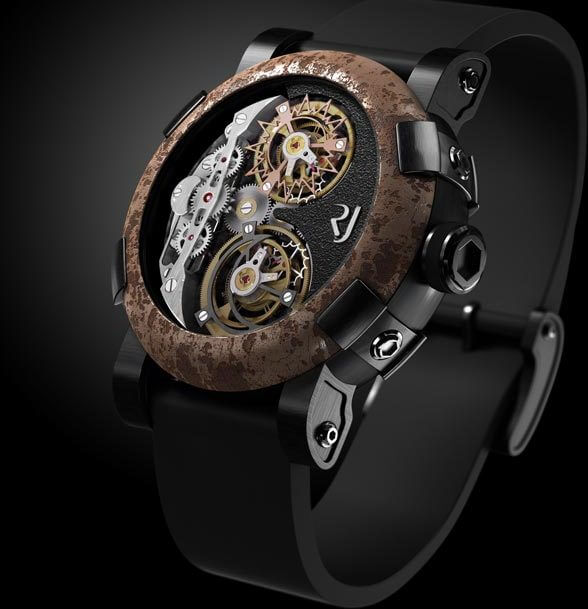Lost time. “Fine Watchmaking Celebrates Sport”, the interesting exhibition at the SIHH in Geneva, included several examples of vintage watches whose dial is protected against shocks, such as the Reverso, created by Jaeger-LeCoultre in 1931 to survive a polo match unscathed, or the Tank basculante imagined by Cartier in 1932. These ingenious protections had, and still have, another quality: they can make time disappear. A flip of the case and passing hours and minutes become an afterthought. Relieved of the pressures of time, the watch’s owner can let his or her mind wander. Almost eight decades later and watchmakers are still making precise time vanish from the dial. Some (Romain Jérôme) by returning to the Ancient Egyptians’ arbitrary measurement of the twelve hours of day and twelve hours of night. Others (Hublot) by setting black hands against an equally black dial. Now that time is displayed everywhere, on mobile phones and every street corner, watches can allow themselves to show time a little less evidently, or differently.
Near future. Soon be Euro 2008. Not long before Euro 2008. Or at least that’s how it felt on Hublot’s stand at Baselworld where Jean-Claude Biver, the brand’s CEO, proved he was football crazy. He presented a Big Bang watch in black ceramic and rubber (the Genevan firm’s signature material) that has been specially designed to time the two halves of a match plus extra time. Joining Jean-Claude Biver on the managers’ bench were Michel Pont (assistant coach of the Swiss football team) and Philippe Magraff (UEFA marketing director). For Hublot is also one of the championship’s official sponsors… and has announced it will forgo its traditional communication in favour of an anti-racism message. Of course this isn’t simply a gesture of goodwill but a strategy and one that also shows the luxury industry hand-in-hand with the most popular sport on earth. According to Jean-Claude Biver, “football is a universal vehicle for communication” that goes beyond social boundaries.
Universal time. Not so long ago, the Journal de la Haute Horlogerie reminded us that Universal Time was born at the International Meridian Conference in Washington in 1884. This arbitrary time divides the earth into 24 zones measured from the prime meridian in Greenwich. At its stand in Basel, the American brand Ball showed footage of a steam train thundering along, a reminder to visitors that the brand was among those that helped coordinate America’s train schedules in the 19th century. The nation’s railroads stretch across four time zones, six including Alaska and Hawaii. The need to coincide arrivals and departures for connecting trains, and to allow trains to pass on what were then single tracks to arrive on time and, most importantly, safely, was one of the main reasons why Universal Time was adopted 124 years ago.
1968 + 1. In 1968, while student uprisings were igniting Paris and soon other cities, the bosses at Seiko were putting the pressure on their engineers and technicians. So what if the Tokyo brand had just won the Geneva Observatory competition for the best mechanical chronometer? The head honchos at Seiko gave their teams just one year to come up with a revolutionary concept for an ultra-precise electronic watch that would measure time using a vibrating quartz crystal. Seiko’s engineers rose to the challenge, as the brand proudly reminded visitors to its stand in Basel. In 1969, the Japanese firm unveiled Astron, the world’s first quartz watch. Soon copied, this crystal-clear idea would shake the Swiss watch industry to the core. Of course it would bounce back, and how, but Seiko’s technological breakthroughs would prove decisive. Today they are commonplace not just in timekeeping but in mobile telephony, IT and digital photography too.
Zeitgeist. A company today must show its environmental colours and tell the world it cares about the future of the planet. The watch industry is no exception. At Baselworld, the main attraction on the Citizen stand was the brand’s Eco-Drive line, which uses solar cells behind the dial to charge the battery. Next stop ecological time.
Long time. On the subject of communication, this time at the SIHH in Geneva, Vacheron Constantin proved itself to be particularly inspired by calling on one of the 19th century’s most famous sons, Gustave Eiffel. Just to make clear that it wasn’t born yesterday, or with the latest fashionable concept, the Genevan Manufacture’s communication emphasised its 250-plus years of continued existence. One of its advertisements showed the Eiffel Tower in 1889, the year of its inauguration in Paris when Vacheron Constantin was already 134 years old! As time becomes more and more compressed, what better than to extol the virtues of longevity, synonymous with wisdom.
Deep in time. If time is the fourth dimension, then brands are busy incorporating the third dimension into their watches. Take Girard-Perregaux, whose Bi-Axial Tourbillon features concentric cages making multi-dimensional rotations. The tourbillon inside Jaeger-LeCoultre’s Reverso Gyrotourbillon 2 also moves in every direction inside a rotating cage. Cartier goes for the same 3D effect but in a big-screen version. A touch of the crown and the Santos Triple 100 reveals three different faces: a classic dial with 12 Roman numerals, a jewelled chequerboard and an engraved tiger face. If ever 1950s 3D cinema comes back into fashion, 2008 watches will be ready to roll!













